13 Aug 2021, last revised 17 Dec 2025
In the early 1900s, the mining industry was nearing its peak production years (6) and Houghton Country was nearing its peak population of over 88,000 (5). So even though there were two well-established breweries in Houghton, the A. Haas Brewing Co. and the Scheuermann Brewery, local capitalists felt there was room for one more. After some back-and-forth prospects, however, the Park brewery was built in Hancock instead of Houghton.
Plans for a New Brewery
In Apr 1906, Joseph Haas was organizing a stock company with others to build and operate a brewery in Houghton, with the proposed site being Haas Park (17). Joseph, formerly of the A. Haas Brewing Co., owned and resided at Haas Park (17). The Park Brewing Co. was incorporated by Joseph Haas, William. H. McGann, Frank Voith, R. Rourke, F. C. Toelle, and E. R. Bathrick with a capitalization of $150,000 divided into $100 shares (25). Papers of association, filed with the county clerk on 21 May 1906, stated that the company was incorporated for "the purpose of manufacturing and selling ale, beer, porter and other malted and brewed liquors..." (1). The organizers elected officers: Joseph Haas, president; Richard Rourke, vice president; Frank J. Voith, secretary; and William McGann, treasurer (20). The company was named The Park Brewing Co. after the fact that it was intended to be located at Haas Park (39).

Newspaper ad - May 1906
At a meeting of the Hancock Businessman's Association in May 1906, the council was asked if Hancock could donate a site for the brewery since most of the businessmen involved preferred the brewery to be located in Hancock (19). Bathrick stated that "the enterprise is already an assured success" (27). Mayor A. J. Scott, who had a drug store in Hancock (see Scott's Drug Store), thought the city could donate a site from the land near Anthony's farm (19). The promoters visited the site and Mayor Scott said the city would sell three acres for $1, allow the use of water for free, and exempt the brewery from taxation for a period of five years (13). But even before visiting the Hancock site, the company had already decided on the Haas Park site and thanked Scott heartily for the generous offer (13). It was Hancock's interest that allowed the company to leverage many concessions with the Haas Park site (13). But then in early Jul 1906, Joseph Haas withdrew from the company and the deal to build at Haas Park was off (21).
The promoters next move was to petition the Hancock city council to deed a site for a nominal price or to lease land on the lake front near the city pumping station for 99 years at low rent (22). In response, a large number of businessmen and residents expressed their opposition to selling or leasing the lake front property, citing concerns that the city water would be contaminated (23). They also felt that the city should not sell or lease land for less than full value with no exemption on taxes (23). At the next city council meeting, Batherick reported that the company had purchased a site in Hancock and did not want free water, taxes, or light (24). The property was purchased on 06 Jul 1906 (26) for $3,100, which was $6,900 less than the asking price for the Haas Park site (11). It consisted of seven lots in the Condon addition in west Hancock, and was bounded by Railroad Ave., Ethel Ave., Emma Ave., and Atlantic St. (26).
A. J. Scott accepted the nomination to be president of the company in Jul 1906 (10). By early Aug, stockholders consisted of over 80 saloon keepers and about 250 men in the liquor trade (11). The organizers would take their pay in stock (11) and the officers would not collect a salary for the first year (19).
Construction of the Brewery
In Jun 1906, the organizers went to Detroit and Cleveland to make arrangements to purchase the construction material and machinery for the brewery (18). The concrete foundations and railroad spurs were laid, but contruction of the brickwork could not commence until the architect delivered plans revised for the Hancock site, which happened in late Aug 1906 (28). In late Sep 1906, the cornerstone inscribed with "Park Brewing Co." was laid and a time capsule containing newspapers, the officer's names, and cards of several spectators was sealed up in stone (30). In Nov 1906, the main building was ready for the construction of the third story and the washhouse and boiler room were ready for a roof (31). The bottling plant and offices would be separate buildings (29). In Mar 1907, Scott, Voith, and McGann went to Chicago to purchase supplies for the brewery, including barrels, bottles, and cases (32).
Completed by early Jul 1907 (33), the brewery building was 100 x 100 ft and five stories at its highest section (40). Construction consisted of a frame of iron and steel, floors of asphalt and concrete, and walls of brick with compressed cork insulation and plaster (33). The only wood to be found was for the doors and window sills (33). Equipment was installed as they arrived (33). The first floor had a boiler room, engine room, wash room, racking room, and cellars (40). The boiler room in the rear held a 150-horsepower boiler that powered the entire brewery (33). The adjoining engine room held a 30-horsepower generator, a 20-horsepower engine to drive the malt machines, malt mills, elevator, and other equipment, and a 60-ton refrigerating (ice) machine (33,40). A water jacket beer cooler, held either in the same room or another room, cooled the beer in pipes after brewing (33,40). A sheet-iron grain store, with nearly a 10,000-bushel capacity, was 10 ft in diameter and 35 ft high extending up to the fourth floor (33). The settling cellars contained a brine tank that held brine used to maintain the temperature of the beer and two 124-barrel capacity, glass-enameled tanks, which held the beer for 20 to 30 hours before it was pumped into the fermenting cellars (33,40). The fermenting cellars contained six 120-barrel capacity vats made of glass-enameled steel (29,40). The chip cellars contained ten 125-barrel capacity tanks (40), in which birchwood chips would draw out any toxins from the beer (33). The stock cellars contained 250-barrel capacity tanks (40). In the racking room, beer was pumped into barrels and kegs (33). The washing room was where kegs and utensils were washed (33). A brew room and a hop room on the second floor held a 115-barrel capacity, solid copper brew kettle with an air-tight lid, a wash tub for washing malt, a 120-barrel capacity mash tub, and a 165-barrel capacity hot water tank that boiled all the water used for brewing (33,40). The third floor had a malt mill with a flake hopper, grits kettle, weighing hoppers, and other equipment (33,40). The fourth floor held a 165-gallon cold water tank and malt storage bins (40). The fifth floor had a condensing room where ammonia used for refrigeration was cooled back to liquid form (40).

Park brewery c.1910

Park brewery c.1935

Bottling Operation
Construction of the Bottling Works
Aside from the brewery, the company also needed a bottling works. In Jul 1907, the company purchased three lots opposite Atlantic St. to be the site for the bottling works (34). Being separated by a wide roadway complied with requirements stating that the bottling department must be separated from the brewery by a considerable distance in order to avoid contamination during the bottling process (34). The bottling room floor and walls of the first story would be concrete, and the rest of the building would be brick with sandstone trim (35). The floor of the basement would be concrete (40). The basement would be used for storing bottles and shooks (40). The main floor would contain the bottling machinery and an office (40). The second floor would be used for storage and a cooperage shop (35,40). A large freight elevator would be installed (35) and a platform would extend from the building to facilitate the loading of wagons and cars (40). The building would be operated by electricity (35). Construction was expected to be completed no later than the middle of Dec (42).
Sanborn maps showed the brewery on the corner of E. Atlantic St. and Emma St., with the bottling works across the street.

Sanborn map - Nov 1907

Sanborn map - Aug 1917
Time to Brew
With the brewery building constructed, it was near time to start brewing and setting plans to market the beer. The brewmaster, Charles Huhn, arrived from Chicago on 02 Jul 1907, and after some remaining machinery got installed, brewing could commence (33). In Aug 1907, the directors appointed McGann as manager and Voith as assistant manager (35). The first beer was made on 22 Aug 1907, and it was expected to be ready for market in late Nov (36). By mid-Nov, McGann had established branches in the principal towns of the Copper Country (39). The day finally arrived, 15 Nov 1907, when the company placed its beer on the market, and it could be found on tap in almost every saloon in Houghton County (41). About two weeks later, the company made its first shipment to Baraga County (2). Their ads specified that their beer was called Park Brew.

Newspaper ad - Nov 1907

Newspaper ad - Nov 1907
The company first released its product in bottles a few days prior to 01 Jan 1908 (43), which means their first bottle dates to 1907. The bottling works was practically completed by 21 Feb 1908, with only some interior painting remaining (44).
Business Matters, Growth, and Expansion
The main offices of the company were established in Houghton, since that was where the company was organized and incorporated, and at the time, it was understood that the brewery would be built in Houghton (37). But because the brewery was built in Hancock instead, some stockholders felt that the offices should be located in Hancock (37). In Nov 1907, the stockholders voted unanimously to move the head offices to Hancock, to be located at the brewery (38). By 01 Jan 1908, the company had moved its offices into temporary quarters at the bottling works (43).
In late Jan 1908, the company decided to double the capacity of its plant and ordered the appropriate equipment (45). The building was constructed to accommodate such growth, but it was not expected to be necessary so shortly after marketing its product (45). A month later, several carloads of cooperage arrived (44); and about a week after that, 16 large, glass-lined, steel storage tanks arrived (44,46). At this time, the directors decided to purchase a new duplicate boiler (46).
The stockholders held their annual meeting in May 1908 (8). The officers were re-elected and they, along with William C. Kauth, comprised the board of directors (8). The company had 100 stockholders, nearly all from the Copper Country (3). The brewery cost approximately $186,000 to construct (3), and it was running at full capacity (8). The only construction expected for the season was the stables, and its foundation had already been laid north of the brewery (8). It was expected that the remaining small debt would be paid and dividends would be issued within a few years (4).
The brewery quickly required further expansion in order to meet increasing demands (47). In Jun 1908, stockholders authorized the issue of a bond of up to $50,000 with plans to build a barn and a cooling room (47), and to expand the capacity of the warehouse (48). The company also planned to purchase new equipment and five teams with wagons (47). It was also noted that if malt, barley, cooperage, and other supplies could be purchased with cash at a reduced price (47), the money saved would offset the interest on the bonds (48). In Mar 1909, construction of the barn was planned for the summer, and it would be able to accommodate 12 horses (49). It is unknown if the barn was actually constructed.

Newspaper ad - Mar 1909

Newspaper ad - Dec 1909
The board reported in Aug 1909 that they had their best quarter, with growing demand and constant expansion of distribution (70). In Sep 1910, the directors declared the first dividend for the company, which would be three dollars per share (50). At this time, the company had two brands, Elite and Park Brew, as well as a porter (50). An ad (see above) indicated that they also made bock beer. The company had branches in Laurium and South Range (50).
At the May 1911 annual meeting, A. J. Scott resigned as president and new officers were elected: D. J. Norton of Ontonagon as president, James Vignetto of Laurium as vice president, and William H. McGann of Houghton as secretary, treasurer, and general manager (9). In addition to the officers, new members of the board of directors were elected: A. B. Saxby and Louis T. Saam, both of Hancock (9).
The brewery had 31 employees in 1910 (14) and 19 employees in 1917 (15). In 1913, 20 unionized employees went on strike with the following demands: employ only union men, a 9-hour work day and a 6-day work week, time-and-a-half overtime pay, higher wages, and no hiring based on a saloonkeeper's recommendation (12). With the support of striking copper miners, the workers got their demands and went back to work (7).
Bottle Embossing
Some of the bottles are embossed with THE PARK, while others have just PARK. It seems these two designs alternated several times and extended into the ABM period. The aqua bottles likely contained a special brand of beer, like it did for other breweries. This special brand was likely Elite since the Elite paper label was found on some unembossed aqua ABM bottles.
Prohibition Hits Michigan
After state prohibition commenced on 01 May 1918 (51), the brewery tried to stay open by manufacturing "soft drinks" (16), but then closed in 1918 (7). National prohibition went into effect on 17 Jan 1920 (52).
Post-Prohibition Revival
National prohibition was amended to legalized the sale of beer and wine with 3.2% alcohol by weight effective 06 Apr 1933 in states without state prohibition laws (53,54). Michigan followed by legalizing such beer and wine on 27 Apr 1933 (55). Breweries first needed to obtain a state license and a federal permit before they could start manufacturing beer (55,56).
The Park brewery reopened, but only after changes in ownership and protracted renovations. W. O. Baysinger and associates of Milwaukee purchased the Park brewery building (57) from the A. Villenalli Oil Company (58) and started to make extensive renovations and repairs in Aug 1933 (57). Their plans including erecting a one-story addition to house offices, a car garage, a storage room, and a workshop (59,60). The new Park Brewing Co. issued 150,000 shares of common stock for sale in Aug 1934 (61) and contracted new equipment in Oct 1934 (62).
In Jan 1935, five Hancock men, Joseph Rock, A. Villanelli, Angelo Vignetto, Narcheso Ricomini, and Julio Manasche, purchased controlling interest in the company from W. O. Baysinger and associates and would soon prepare the building for the installation of machinery (63). The officers consisted of Angelo Vignetto as president, Konsta Rahkola as vice president, Joseph Rock as secretary and treasurer, and John G. Glanville as assistant secretary (64). They along with Angelo Villanelli, Narcisco Riciomini, and Giulio Maneschi comprised the directors (64).
The first shipment of equipment consisted of a 100-barrel kettle, a mash tub, and a rice cooker (64). In Feb 1935, two high pressure boilers, pumps, and coal bins were installed (65). In Mar 1935, additional equipment (65) and insulation (66) arrived; and machinery for the ice storage plant was expected to arrive in a week or so (66). In Nov 1935, the last of the major equipment, including tanks and fermenting tubs, were purchased; and brewmaster Adolph Schmidt arrived from LaCrosse, WI (67). The brewery would have a capacity of 60,000 barrels per year (67). With much fan-fair, the brewery marketed it beer again on 18 Jul 1936, but only in kegs, with bottled beer to be released at a later date (68). The company then advertised on 19 Jan 1937 that Park Brew was now available in bottles (69). No embossed bottles have been discovered for this post-prohibition period, indicating that the company used generic bottles with paper labels. In 1941, the brewery was sold and the A. Haas Brewing Co. moved into the facility (7).

Park Brew label

Park Elite label

Stock Certificate - 1906
Citations
- anonymous. (1906, May 22). Papers are filed. The Daily Mining Gazette (Houghton, MI). p. 8.
- anonymous. (1907, Nov 30). Local items. The L'Anse Sentinel (L'Anse, MI). p. 1.
- anonymous. (1908, May 30). Park Brewery Co. officers. The L'Anse Sentinel (L'Anse, MI). p. 1.
- anonymous. (1908, May 21). Brewing company election. The Evening Journal (Hancock, MI). p. 8.
- US Decennial Census. US Census Bureau. www.census.gov.
- wikipedia.org. accessed 2021. Copper Mining in Michigan. en.wikipedia.org/wiki/Copper_mining_in_Michigan
- Magnaghi, R. M. 2015. Upper Peninsula Beer: A History of Brewing Above the Bridge. American Palate. Charleston, SC.
- anonymous. (1908, May 21). Park Brewing Company meets. The Calumet News (Calumet, MI). p. 2.
- anonymous. (1911, May 18). Park Brewery meeting. The Calumet News (Calumet, MI). p. 1.
- anonymous. (1906, Jul 15). Hancock brevities. The Daily Mining Gazette (Houghton, MI). p. 3.
- anonymous. (1906, Aug 03). Park Brewing Company. The Evening Journal (Hancock, MI). p. 8.
- anonymous. (1913, Jul 12). Strike on the Park Brewery. The Calumet News (Calumet, MI). p. 3.
- anonymous. (1906, May 22). Hancock site turned down. The Daily Mining Gazette (Houghton, MI). p. 3.
- State of Michigan Department of Labor. 1911. Second Annual Report of the Department of Labor of the State of Michigan. Wynkoop Hallenbeck Crawford Co., State Printers. Lansing, MI.
- Michigan Bureau of Labor and Industrial Statistics. 1918. Thirty-Fifth Annual Report of the Department of Labor of the State of Michigan. Wynkoop Hallenbeck Crawford Co., State Printers. Lansing, MI.
- State of Michigan Department of Labor. 1919. Thirty-Sixth Annual Report of the Department of Labor of the State of Michigan. Fort Wayne Printing Co. Fort Wayne, Indiana.
- anonymous. (1906, Apr 28). A new brewery. The Evening Journal (Hancock, MI). p. 1.
- anonymous. (1906, Jun 08). Men interested in brewery go on trip. The Copper Country Evening News (Calumet, MI). p. 2.
- anonymous. (1906, May 16). To ask for site. The Copper Country Evening News (Calumet, MI). p. 2.
- anonymous. (1906, May 19). Country brevities. The Copper Country Evening News (Calumet, MI). p. 2.
- anonymous. (1906, Jul 01). Park Brewing deal off. The Daily Mining Gazette (Houghton, MI). p. 8.
- anonymous. (1906, Jul 03). Brewing company asks for site. The Daily Mining Gazette (Houghton, MI). p. 3.
- anonymous. (1906, Jul 04). Many people do not favor plan. The Daily Mining Gazette (Houghton, MI). p. 3.
- anonymous. (1906, Jul 07). Brewing co. buys site in Hancock. The Daily Mining Gazette (Houghton, MI). p. 3.
- anonymous. (1906, May 10). Park Brewing Co. The Evening Journal (Hancock, MI). p. 5.
- anonymous. (1906, Jul 07). The new brewery. The Evening Journal (Hancock, MI). p. 8.
- anonymous. (1906, May 16). Brewery project before council. The Daily Mining Gazette (Houghton, MI). p. 3.
- anonymous. (1906, Aug 30). Brewery plans. The Evening Journal (Hancock, MI). p. 8.
- anonymous. (1906, Sep 08). The Park Brewery. The Evening Journal (Hancock, MI). p. 8.
- anonymous. (1906, Sep 28). Had a good time. The Evening Journal (Hancock, MI). p. 8.
- anonymous. (1906, Nov 10). Progress on brewery. The Evening Journal (Hancock, MI). p. 8.
- anonymous. (1907, Mar 20). Hancock brevities. The Daily Mining Gazette (Houghton, MI). p. 3.
- anonymous. (1907, Jul 03). The new brewery. The Evening Journal (Hancock, MI). p. 8.
- anonymous. (1907, Jul 20). Buys more land. The Evening Journal (Hancock, MI). p. 8.
- anonymous. (1907, Aug 15). Contract for new bottling works let. The Daily Mining Gazette (Houghton, MI). p. 3.
- anonymous. (1907, Aug 24). Hancock brevities. The Daily Mining Gazette (Houghton, MI). p. 3.
- anonymous. (1907, Nov 09). Move head offices. The Daily Mining Gazette (Houghton, MI). p. 3.
- anonymous. (1907, Nov 12). Move head offices. The Daily Mining Gazette (Houghton, MI). p. 3.
- anonymous. (1907, Nov 13). New beer will be put on market in few days. The Calumet News (Calumet, MI). p. 4.
- anonymous. (1907, Nov 15). The Park Brewery. The Evening Journal (Hancock, MI). p. 9.
- anonymous. (1907, Nov 16). New beer on tap. The Daily Mining Gazette (Houghton, MI). p. 3.
- anonymous. (1907, Nov 24). Will wire bottling plant. The Daily Mining Gazette (Houghton, MI). p. 8.
- anonymous. (1908, Jan 01). Hancock brevities. The Daily Mining Gazette (Houghton, MI). p. 3.
- anonymous. (1908, Feb 21). Additional equipment for Park Brewery is received. The Calumet News (Calumet, MI). p. 3.
- anonymous. (1908, Jan 24). Will enlarge plant. The Calumet News (Calumet, MI). p. 4.
- anonymous. (1908, Feb 29). Purchase new boiler. The Daily Mining Gazette (Houghton, MI). p. 3.
- anonymous. (1908, Jun 10). To improve brewery. The Evening Journal (Hancock, MI). p. 8.
- anonymous. (1908, Jun 30). To enlarge brewing plant. The Evening Journal (Hancock, MI). p. 4.
- anonymous. (1909, Mar 17). Breweries of city to do building work soon. The Daily Mining Gazette (Houghton, MI). p. 3.
- anonymous. (1910, Sep 04). Initial dividend is declared by brewery. The Daily Mining Gazette (Houghton, MI). p. 3.
- anonymous. (1919, Feb 14). National and state prohibition. The L'Anse Sentinel (L'Anse, MI). p. 8.
- Prohibition in the United States. (2024, Dec 27). In Wikipedia. https://en.wikipedia.org/wiki/Prohibition_in_the_United_States
- anonymous. (1933, Mar 23). Roosevelt O.K. put on beer bill. The Daily Mining Gazette (Houghton, MI). p. 1.
- anonymous. (1933, Mar 23). Provisions of U.S. beer bill. The Daily Mining Gazette (Houghton, MI). p. 5.
- anonymous. (1933, Apr 28). Cameras record end of 15 years of prohibition. The Daily Mining Gazette (Houghton, MI). p. 1.
- Shilson, G. T. (1933, May 03). State board licenses 8 breweries. The Daily Mining Gazette (Houghton, MI). p. 1.
- anonymous. (1933, Aug 17). Start repair work today on Park Brewery. The Evening Copper Journal (Hancock, MI). p. 3.
- anonymous. (1933, Aug 18). Reconditioning of Park Brewery is begun by workmen. The Daily Mining Gazette (Hancock, MI). p. 3.
- anonymous. (1933, Aug 18). Plan to make addition to beer plant. The Evening Copper Journal (Hancock, MI). p. 3.
- anonymous. (1933, Sep 27). Large addition being constructed on Park Brewery. The Evening Copper Journal (Hancock, MI). p. 8.
- anonymous. (1934, Aug 07). Sale of stock in new Park Brewery begun. The Evening Copper Journal (Hancock, MI). p. 8.
- anonymous. (1934, Oct 22). Brewery signs contract for new equipment. Evening Copper Journal (Hancock, MI). p. 8.
- anonymous. (1935, Jan 17). Park Brewery goes into new hands in deal. Evening Copper Journal (Hancock, MI). p. 8.
- anonymous. (1935, Jan 30). Installation of equipment to begin soon. Evening Copper Journal (Hancock, MI). p. 8.
- anonymous. (1935, Mar 03). Park Brewery Co. equipment reaches Hancock Saturday. The Daily Mining Gazette (Houghton, MI). p. 3.
- anonymous. (1935, Mar 23). Insulating material received at brewery; Work is progressing. The Daily Mining Gazette (Houghton, MI). p. 3.
- anonymous. (1935, Nov 08). Brewing equipment at Park Brewery installed Monday. The Daily Mining Gazette (Houghton, MI). p. 3.
- anonymous. (1936, Jul 18). Modern brew is marketed by Park company today. Evening Copper Journal (Hancock, MI). p. 4.
- anonymous. (1937, Jan 19). Park Brewing Co. ad. Evening Copper Journal (Hancock, MI). p. 6.
- anonymous. (1909, Aug 27). Park company's business. Evening Copper Journal (Hancock, MI). p. 1.
color: amber
top: crown top - tooled
base: post-bottom
maker's mark: ROOT (base)
other marks: (none)
date: 1907
rarity: scarce
- full mold plate
- serifs on PARK
color: amber
top: crown top - tooled
base: post-bottom
maker's mark: A B Co. (base)
other marks: (none)
dated: 1908
rarity: common
- different plate design
- THE above PARK
- back heel has date code 8 - S
color: amber
top: crown top - tooled
base: post-bottom
maker's mark: A B Co (base)
other marks: (none)
dated: 1908
rarity: common
- export-shaped mold
- back heel has date code 8 - S
- same plate for 114 and 117
color: aqua
top: crown top - tooled
base: post-bottom
maker's mark: A B Co. (base)
other marks: (none)
dated: 1908
rarity: common
- same plate for 114 and 117
- different color
- back heel has date code 8 - S
color: amber
top: crown top - tooled
base: post-bottom
maker's mark: A B Co (base)
other marks: (none)
dated: 1908
rarity: rare
- pint-sized complement to 114
- back heel has date code 8 - S
- same plate for s61 and 118
color: aqua
top: crown top - tooled
base: post-bottom
maker's mark: A B Co. (base)
other marks: (none)
dated: 1908
rarity: common
- same plate for s61 and 118
- different color
- pint-sized complement to 117
- back heel has date code 8 - S
color: amber
top: crown top - tooled
base: post-bottom
maker's mark: A B Co. (base)
other marks: (none)
dated: 1910, 1913
rarity: common
- pint-sized complement to 113
- back heel has date code S - 13
- another example has date code 0 - S (for 1910)
color: amber
top: crown top - tooled
base: post-bottom
maker's mark: N B B G CO (back heel)
other marks: (none)
date: 1909-1912
rarity: common
- no THE above PARK
- uppercase "O" in CO.
- different bottle maker
color: aqua
top: crown top - tooled
base: post-bottom
maker's mark: N B B G CO. (base)
other marks: (none)
date: 1909-1912
rarity: scarce
- uppercase "O" in CO.
color: amber
top: crown top - ABM
base: post-bottom
maker's mark: W. F. & S. MIL. (base)
other marks: (none)
date: c.1915
rarity: common
- T in REGISTERED under C in HANCOCK
other marks: (none)
dated: 1910
rarity: common
- different plate from abm-28
- T in REGISTERED right of C in HANCOCK
- heel has "10 12", which might be a date code
other marks: (none)
dated: 1909
rarity: common
- different plate from abm-28 and abm-28a
- lowercase "o" in Co
- THE above PARK stamped out
- heel has "9 1", which might be a date code
color: aqua
top: crown top - ABM
base: post-bottom
maker's mark: (none)
other marks: (none)
dated: 1912
rarity: common
- the heel has "12 1", which might be a date code
color: aqua
top: crown top - ABM
base: post-bottom
maker's mark: (none)
other marks: (none)
dated: 1916
rarity: common
- back heel has A B Co. date code 16 S 1
color: amber
top: crown top - ABM
base: post-bottom
maker's mark: (none)
other marks: (none)
dated: 1917
rarity: common
- back heel has A B Co. date code 17 S 1
















